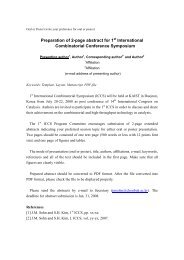Bidding - the International Association of the Catalysis Societies
Bidding - the International Association of the Catalysis Societies
Bidding - the International Association of the Catalysis Societies
Create successful ePaper yourself
Turn your PDF publications into a flip-book with our unique Google optimized e-Paper software.
decades. Catalyst industry that began in 1991 enjoyed a healthy 28.6% growth per year,<br />
and produces catalysts valued in excess <strong>of</strong> 100 million U.S. dollars, while Korean<br />
industries import about 250 million U.S. dollars worth <strong>of</strong> catalysts, not counting <strong>the</strong><br />
catalysts embedded in licensed technologies.<br />
The petrochemical industry, which began with a planned ethylene production capacity<br />
<strong>of</strong> 100,000 metric tons per year in 1968, grew by leaps and bounds. Ethylene capacity<br />
stands at 5 million metric tons, a 50-fold increase in <strong>the</strong> quarter century that ended in<br />
1993, making Korea <strong>the</strong> fifth largest ethylene producer in <strong>the</strong> world. Much effort is<br />
being expended in order to develop catalytic technologies for manufacturing<br />
downstream chemical intermediates from <strong>the</strong> outputs <strong>of</strong> naphtha crackers.<br />
Chemical industries account for about 20% <strong>of</strong> Korean GDP, which is <strong>the</strong> 11 th largest in<br />
<strong>the</strong> world. The rise <strong>of</strong> chemical industries in 1960s heralded <strong>the</strong> economic development<br />
<strong>of</strong> Korea, and <strong>the</strong> catalysis community has a vital role to play in <strong>the</strong> growing sector <strong>of</strong><br />
<strong>the</strong> economy. Catalytic technologies have yet to reach a mature phase in Korea, thus <strong>the</strong><br />
catalysis community has an increasingly vital role to play in <strong>the</strong> growing sector <strong>of</strong> <strong>the</strong><br />
economy. Collaborative efforts between <strong>the</strong> academic/research community and<br />
industrial practitioners will bring about <strong>the</strong> fruition <strong>of</strong> <strong>the</strong> 2 decades <strong>of</strong> activities in <strong>the</strong><br />
form <strong>of</strong> a large number <strong>of</strong> indigenous catalytic technologies, both for domestic use and<br />
export.<br />
This brief introduction to catalysis-related activities will close with a somewhat larger<br />
picture <strong>of</strong> Korea’s total R & D efforts. Korea has been devoting an increasing portion <strong>of</strong><br />
its GDP toward R & D expenditures during <strong>the</strong> past two decades. After reaching 1% <strong>of</strong><br />
GDP in 1982, it kept rising until it reached 2% in 1991, 2.5% in 1995, and has remained<br />
above 2.5% ever since, which is one <strong>of</strong> <strong>the</strong> highest among <strong>the</strong> OECD member countries.<br />
Considering that Korean economy has experienced one <strong>of</strong> <strong>the</strong> fastest growths in <strong>the</strong><br />
world during <strong>the</strong> past few decades, this increase in R&D outlay is significant. In terms<br />
<strong>of</strong> <strong>the</strong> government expenditure, 5% <strong>of</strong> <strong>the</strong> national budget was earmarked for R&D in<br />
<strong>the</strong> year 2003. R&D manpower per 1000 in <strong>the</strong> labor force is approaching 5, which is<br />
quite close to <strong>the</strong> average for <strong>the</strong> G7 nations.<br />
- 62 -



